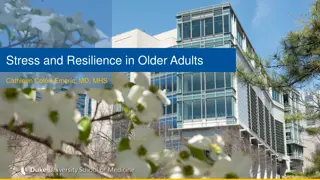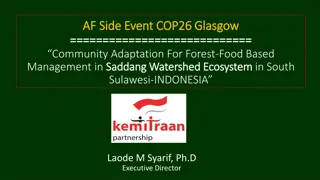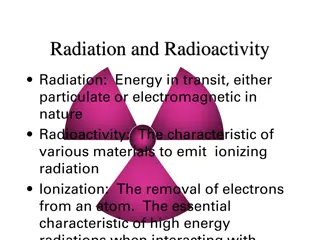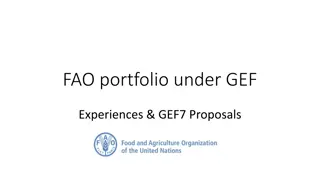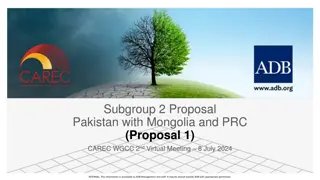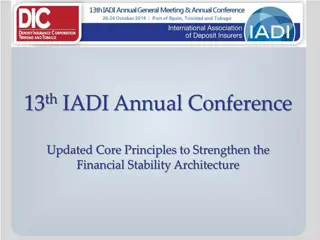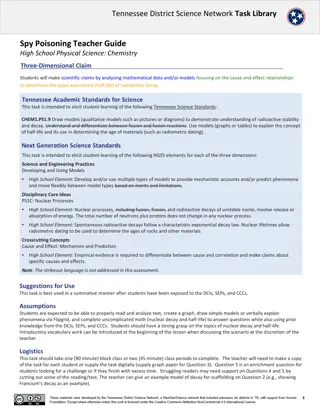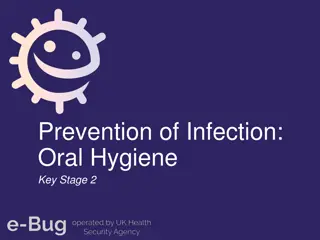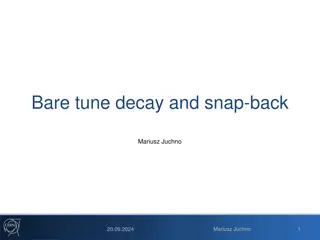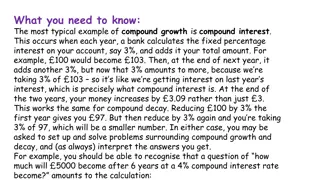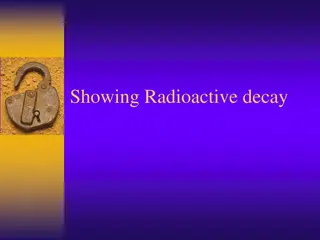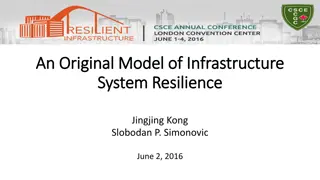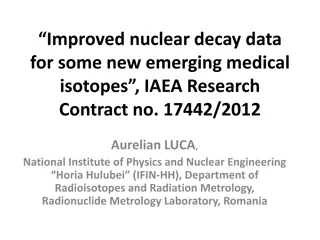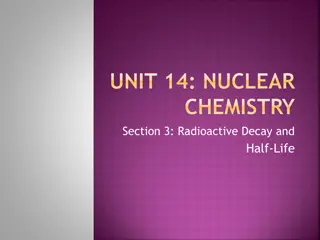Enhancing Resilience: US Insurers' Role in Combating Infrastructure Decay and Climate Challenges
Explore how US insurers can contribute to resilience-building efforts amid infrastructure decay and climate-related challenges. The discussion covers historical perspectives, public-private partnerships, notable climate disasters, and the imperative for proactive action by policymakers. Discover the potential benefits of a collaborative approach and the urgency of addressing the resilience gap.
Download Presentation

Please find below an Image/Link to download the presentation.
The content on the website is provided AS IS for your information and personal use only. It may not be sold, licensed, or shared on other websites without obtaining consent from the author. Download presentation by click this link. If you encounter any issues during the download, it is possible that the publisher has removed the file from their server.
E N D
Presentation Transcript
DISCLAIMER: THE VIEWS CONTAINED HEREIN ARE PERSONAL; THEY DO NOT REPRESENT THE VIEWS OF MY CLIENTS, COLLEAGUES, FORMER EMPLOYERS OR THIS CONFERENCE AND I MIGHT FORESWEAR THEM LATER. Presented By: Andrea M Corcoran
How US Insurers can be part of a Program to Combat Infra-structure Decay and Adverse Climate Symptoms THE RESILIENCE PROJECT AND WHY US POLICY MAKERS SHOULD ACT PRO -ACTIVELY TO HELP
Public-Private Virtuous Circle ENHANCED RESILIENCE PRIVATE P&C INSURANCE PUBLIC SECTOR PROGRAM BENEFITS Prepaid local disaster funds; distribution for federal programs Premiums Economic , social benefit: reduced public costs; Pre- disaster mitigation Smaller Fiscal claim Infrastructure improvement or additions Infrastructure Investment in sub-sovereign and corporate debt Account holder redress Private redress; reduced public impact
US early recognized private insurance as a public good In mid-1800 s Herman Melville author of Moby Dick wrote on math of whaling insurance incidentally, whale oil being the clean energy of its time Benjamin Franklin invented mutual fire insurance pooling homeowners and fire brigades in 1752 before the US declared independence; and later applied idea to crop insurance.
Why review partnership balance now: Increasing awareness of insufficient mitigating infra-structure and our resilience gap IDENTIFIED: THE BIGGEST US CLIMATE INSURANCE DISASTERS Failed, insufficient, untimely State and Federal response 2005(No.1) Hurricane Katrina Insufficient funding for pre-disaster planning and post disaster remediation 2017 (Largest cumulative losses) Harvey (Texas), Irma (US Virgin Islands and Florida Keys) Maria (Puerto Rico) Lack of urgency to repair or augment decaying infrastructure despite awareness of change in scope of disasters 2013 (No.3) Hurricane Sandy Up to 2/3 of potentially vulnerable uninsured Rise in premiums and additional conditionality resulting in individuals and businesses going bare
XXXXXX XX Billion USD (CPI adjusted) disasters by number of incidents 1980 to 2020 Source NOAA
Data Source NOAA and Statistica
US SYSTEM (vastly simplified) Member Chairs: Board of Governors Federal Reserve, FDIC, OCC, CFTC, SEC oversight of SIFIS (no US insurers) FDIC manages deposit insurance; liquidation, resolution authority INSURANCE Financial Stability Oversight Committee (FSOC) Chair Secretary of Treasury (MOF) 50 State insurance commissioners 50 State guaranty funds NAIC model laws and standards SEC banking committee; CFTC agriculture committee Board of Governors of Federal Reserve (Central Bank) Bank Holding Cos. monetary policy; emergency liquidity, margin, treasuries, currency Plus 11 regional Reserve Banks (Reserve System) Separate accounting CONGRESS (oversight committees) Executive OCC-national banks, Federal Insurance Office of Department of Treasury (access and international prudential standards), Federal criminal enforcement SEC; CFTC (independent regulatory authorities) FINRA, NFA, Securities, derivatives, exchanges, clearing, SEFs, funds (including insurance annuities, separate accounts), advice, other Executive Dept of Agriculture (crop insurance), FEMA (National Flood Insurance Program) as of 2003 part of Department of Homeland Security
US P&C Insurance Framework State by state regulation as a matter of law post 1945 build back better period National Association of Insurance Commissioners ( NAIC): model legislation for permitted investments, standards for accounting and valuation, information exchange protocols as well as national disaster planning, drawn on or adopted by States (some optionality unlike EU system) Special accounting principles do not converge with IFRS, GAAP or EU Solvency, capital and investment limitations different from those for banks and internationally All 50 States, Puerto Rico, the US Virgin Islands and DC have a guaranty mechanism (by line) to pay covered claims arising from insolvency of insurers licensed in that state*. NAIC model legislation defines role of mutual P&C Guaranty Associations. Association members are insurers who also serve on governance entity. Model Act provides for power to transfer customers to solvent insurers Potential bespoke State approaches for tailoring to local circumstances, funding of local infrastructure and testing of new ideas (est. 2500 P&C insurers) *or by specified amount of net premiums
THE MAGIC of the TO TEST IDEAS STATES LIKE FINTECH LAB or INNOVATION HUBS
US P&C relationship with banks and sur-tech One-year premium time-horizon; not like bank deposits ( which are effectively unsecured, time-unlimited loans to banks); capital calculations different from those for banks Not part of Federal Reserve emergency liquidity facility. AIG had to become bank to receive post 2008-2009 financial crisis assistance. Typically, stand-alone joint stock or mutual companies; less than 10 insurance-led usually thrift groups and since 2018 no insurance SIFIs NAIC and 50 States participate with the Board of Governors of US Federal Reserve (holding companies) and the Federal Insurance Office of the Department of Treasury (access and international prudential standards) in the IAIS P&C companies may hedge using listed derivatives or via cleared over-the-counter swaps through intermediary banks; no speculation May use sur-tech for distribution and claims management not underwriting
P&C insurers as investors 1 2 3 Large institutional investors; hold 1/3 of approximately 5.7 trillion in USD assets Invest 50% or more of assets in sub-sovereign and corporate debt, which may be held to maturity Have patient capital to invest
Amplifying accessibilityachieving scale economies at economic cost State law may Mandate insurance, reinsurance or participation in public-private pool Have non-prescriptive prudential investment policies consistent with rules against speculation and rating* requirements Define how reinsurance can expand capacity to underwrite and ability to fund claims by: Proportional (percentage of single insurer claims coverage) Portfolio (multiple reinsurers) Permit sale of catastrophe bonds and securitization of various types (ILS) *But remember the 2008-2009 crisis which was partly a rating crisis
Policies amplifying public good of private insurance Insurance mandates, including required reinsurance (auto accident injuries, workmen s comp, in connection with federal or State assistance, such as floods, earthquakes) Tax abatement for sub-sovereign investment Loan guarantees, subsidies for disaster mitigating infra- structure investments, green finance Codes to reduce insured risks (such as fire safetu, seat belts, building stability) Zoning to prevent building in flood plains or other prescribed conditions of insurability; payment for resettlement Location funds (Federal flood insurance program) Private and public risk pooling (California Earthquake Authority) Further use of public reinsurance in extreme circumstances resilience reinsurance State and Federal backstops
Some questions to ask when designing a Resilience Project
?When is private reinsurance not enough? In what if any extreme but not implausible scenarios is a public backstop needed? Can public sector reinsure reinsurers? ?How can the public sector enable a stronger, more reliable private response and reinforce the virtuous circle to mutual benefit? ?How can public sector profit from private sector analysis and expertise? And vice versa? ?Can public sector further incentivize private investment by insurers directed at infrastructure improvement to mitigate adverse effects of climate that may reduce future public costs and increase prevention ? ?Who should do what? And where will the money come from?
?Will public support be criticized as creating moral hazard or applauded for improving systemic resilience? See existing models: Deposit Insurance 1930 Multi-peril crop insurance 1938 National Flood Insurance Act 1968 reauthorized until Sept. 2021 SIPA, securities compensation 1974 50-State individual guaranty associations ? Should pricing be more transparent? ? Is this not the time when the body politic is amenable to outsize responses to outsize problems?
Can joined forces strengthen the virtuous circle? Beyond reinsurance-- resilience protection Insurers insure against disaster consequences and invest assets in infra- structure More funds for pre- disaster, infra- structure REINFORCES RESILIENCE PUBLIC SECTOR AMPLIFIES FUNDS and IMPACT Communities companies finance risk mitigating projects Reinsurance expands scope and accessibility THE RESILIENCE PROJECT
IMAGINE INSURANCE SUPER -HEROES AND POLICY MAKERS JOIN FORCES FOR MOON SHOT ENHANCEMENT OF RESILIENCE TO COMBAT OUTSIZE DISASTERS AND TO REMEDIATE AND TO BUILD NEW MITIGATING INFRASTRUCTURE !!!!!












